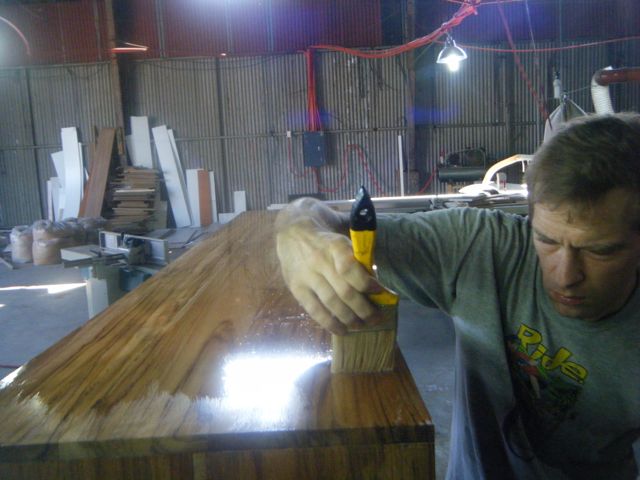Spraying Opaque Finishes on Millwork
Here's a lot of information on spraying acrylic paint (and its drawbacks), plus some advice on better opaque pigmented coating choices. June 18, 2013
Question
I would like to start spraying acrylic paints, i.e. SW Pro Classic, BM Satin Impervo. I would like to spray from a pressure pot. HVLP or not? Tip size? Thinning? Pot pressure? Gun pressure? Coat thickness? Paint conditioners? Clear coat over paint, what brands? Recoat times? Dry times to stack and ship, like bundling shelves or trim, do you wrap paint on paint or do you put paper between?
Forum Responses
(Finishing Forum)
From contributor C:
BM Impervo is out of the question as an acrylic. It is an alkyd type coating that has a long drying time compared to any acrylics.
Beyond that, your questions are too broad. I'm assuming you have a spray booth, since you would like to use a pressure pot and gun. As to how much pressure, type of gun, fluid tip/needle size, thickness, reduction, dry times and packing, depending on what forms you'll be spraying and the atmospheric conditions of your shop, there is a wide range of answers.
You want to spray aqueous coatings, correct? Or, since you mentioned Impervo, are alkyds or lacquers also acceptable?
From contributor M:
She wants to spray interior latex paint, on millwork, maybe even case goods. It is not a good idea. She should hire a finisher. A finisher would recommend either a pigmented conversion varnish or a pigmented lacquer.
From contributor R:
There might be other coatings available for your particular application. Is there a reason you have chosen these particular products?
From Paul Snyder, forum technical advisor:
Ben Moore waterborne acrylic satin Impervo or Regal eggshell are both good choices for a sprayed house paint finish. We spray them all the time with excellent results. The main benefit they offer is ease of repair and recoating.
The spray equipment we use with this paint includes:
Binks Mach 1 gun with a 3M PPS cup (1.5 mm needle)
Binks Mach 1 gun on a pressure pot (1.5mm needle)
Graco 395 air assisted airless
The airless is a lot faster than the HVLP spray gun.
House paint takes a long time to dry/cure compared to other coatings like lacquer, pre-catalyzed lacquer, conversion varnish, or catalyzed polyurethane. And it doesn't level out as nicely to produce a smooth, furniture grade finish. The slow cure time means you'll have to wait at least a day before wrapping the items with soft foam or paper before shipping. It takes 30-60 days to reach full cure before the paint reaches its maximum durability. The first week or two it's susceptible to sticking (aka, blocking) to other painted pieces that are stacked against it.
If you're planning to do furniture grade finishing, with more durability, and a shorter dry to stack/ship time is important, you should consider using a different finish. Do you have a proper spray booth and the associated equipment?
From contributor R:
Read Paul Snyder's statements and follow them to the letter. If you are doing this for a client and want to produce a professional, high end product that will last their lifetime, do not spray latex paint. Switch to, at the very least, a waterborne lacquer coating such as Valspar's Zenith or General Finish products. Latex paint is for house painters!
From contributor A:
Formula for interior millwork, not kitchen or bath cabinets. Spray Zinsser Bin white pigmented with hvlp 1.5 needle and tip. Two coats. Spray waterborne Impervo with Titan airless spray rig ED655 plus. Two coats. Many would be shocked how nice it comes out. Advantages: available locally, cheaper, no charge for tinting, no shipping charge, touch up friendly. If you run short, just go back to store. Most of the BM stores are open on weekends. The satin Impervo is more like semi-gloss if you don't thin. You should not have to thin with that airless rig I mentioned. I have not sprayed Bin in the airless as I think it will be too hard to clean. Cleaning airless rig takes about 30 minutes.
From contributor P:
The confusion surrounding Impervo is understandable. There are multiple products that use that name, and they are completely different. Regular Impervo is alkyd, and then there's waterbased Satin Impervo, which is indeed 100% acrylic and is sprayable. It's doubly confusing that they call it "satin," as that's usually associated with a sheen level. The Satin Impervo sprays okay, but it doesn't hold a candle to other waterbased pigmented finishes from ML Campbell, General Finishes, Fuhr, ICA, etc. Those finishes can all be mixed to match Ben Moore and other colors, if that's important to you. The only advantage to using the paint store product is the ability to walk in the paint store and buy a can on the spot.
From contributor A:
I've had really good luck with the Impervo. Maybe it's spraying technique or something. I find most water borne primers have trouble getting rid of the grain pattern, especially with poplar, but even notice it with maple. Painters say to use oil base primer and then topcoat with acrylic to eliminate the grain issue. Turns out the oil primer is $20 a gallon and can dry in 40 degree temperatures, a real plus for some that have problems heating a spray room.
I have shipped a few items Fedex. You may find the Impervo parts stick to one another if you're planning on shipping. The stickiness lessens if you don't add water to the paint. Someone suggested using wax paper between parts and that does seem to work. You just don't know if your product is sitting in a hot truck what will happen to any of these topcoats. I think solvent conversion varnish is probably best, I just don't have the proper heat for my spray area.
